| dc.description.abstract | Child marriage is any formal marriage or informal union where one or both parties are under 18 years of age. Child marriage affects both boys and girls, but disproportionately affects girls. Each year, 15 million girls are married before the age of 18, and that number is growing. Worldwide, 700 million women alive today were married before their 18th birthday and more than one in three girls are married before age 15 (UNICEF 2014, 1). Although the largest numbers of child brides are in South Asia, most of the countries with the highest prevalence of child marriage are in Africa (African Union 2015, 3). Sudan is among the African countries with a high prevalence of child marriage. In 2010, 10.7% of girls and women ages 15 to 49 were married before the age of 15, and 38% were married before the age of 18 (CBS and UNICEF 2010). [1]
Child marriage is a human rights violation affecting children’s and women’s rights to health, education, equality, non-discrimination, and freedom from violence and exploitation. Child marriage has harmful effects on young girls. Neither physically nor emotionally ready to become wives and mothers, child marriage exposes young girls to a wide range of health risks. The minds and bodies of young girls are physically unprepared for sexual activity and childbirth, increasing the dangers of maternal health complications. Early pregnancy increases the risk of both maternal and child mortality. Added to that, girl brides are more likely to suffer domestic violence and marital rape. Child brides are rarely allowed to continue their education. With limited access to education and subsequent economic opportunities, child brides and their families are more likely to live in poverty.
[1] The 2006 SHHS (Sudan Household Health Survey) showed that 14.6% of women ages 25 to 29 and 6.9% of girls ages 15 to 19 had married before the age of 15 (FMH and UNICEF 2006). Available statistical evidence shows that the practice | |
